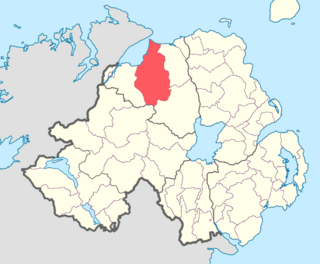Related Research Articles

The Kings of Ailech were the over-kings of the medieval Irish province of Ailech in north-western Ireland. It encompassed the territories of the Cenél nEógain and Cenél Conaill. After the battle of Cloítech in 789 its kings were exclusively from the Cenél nEógain. The royal fort for Ailech was the Grianan of Aileach, a hillfort on top of Greenan Mountain in modern-day County Donegal, Republic of Ireland.

Domhnall Ua Lochlainn, also known as Domhnall Mac Lochlainn, was king of the Cenél Eogain, over-king of Ailech, and alleged High King of Ireland.
The Mac Lochlainn were a leading branch of the Cenél nEógain and during the early medieval period, the most powerful clan in the Northern Uí Néill. They descended from Domnall Dabaill, son of Áed Findliath. Another son of the latter was Niall Glúndub eponymous ancestor of the Ua Néill. As a result of their descent from Domnall Dabaill, the Mac Lochlainn were known as Clann Domnaill or Clann Domhnaill. The eponym behind the surnames Mac Lochlainn andÓ Lochlainn,—is Lochlann mac Máelsechnaill, King of Inishowen. The surnames themselves formed not as a result of Lochlann's prominence, but as a consequence of the remarkable success of his grandson, Domnall Ua Lochlainn.
Domhnall ua Néill was High King of Ireland from 956 to 980.
Muirchertach mac Néill, called Muirchertach of the Leather Cloaks, was a King of Ailech.
Éogan is an early Irish male given name, which also has the hypocoristic and diminutive forms Eoganán, Eóghainin, Eóghain and Eóghainn. The Modern Irish form of the name is Eoghan.

Airgíalla was a medieval Irish over-kingdom and the collective name for the confederation of tribes that formed it. The confederation consisted of nine minor kingdoms, all independent of each other but paying nominal suzerainty to an overking, usually from the most powerful dynasty. Airgíalla at its peak roughly matched the modern dioceses of Armagh and Clogher, spanning parts of counties Armagh, Monaghan, Louth, Fermanagh, Tyrone and Londonderry. Its main towns were Armagh and Clogher. The name's usage survives as a cultural area of folk tradition in South East Ulster and adjoining areas of County Louth.
Ruaidrí ua Canannáin was king of the Cenél Conaill, and according to some sources, High King of Ireland.
Muirchertach mac Muiredaig, called Mac Ercae, Muirchertach Macc Ercae and Muirchertach mac Ercae, was said to be High King of Ireland in the 6th century. The Irish annals contain little reliable information on his life, and the surviving record shows signs of retrospective modification. The Aided Muirchertaig Meic Erca takes as its theme Muirchertach's supernatural death.
Suibne Menn was an Irish king who is counted as a High King of Ireland.
Báetán mac Muirchertaig, also Baetán Bríge, was an Irish king who is included in some lists as a High King of Ireland. He was the son of Muirchertach mac Muiredaig, also considered a high king. He was a member of the Cenél nEógain branch of the northern Uí Néill. He ruled in Ailech from 566 to 572.
Eochaid mac Domnaill, also Eochaid Find, was an Irish king who is included in some lists as a High King of Ireland. He was the son of Domnall Ilchelgach and grandson of Muirchertach mac Muiredaig, also considered high kings. He was a member of the Cenél nEógain branch of the northern Uí Néill. He ruled in Ailech from 565 to 571.
Colcu mac Domnaill was a member of the Cenél nEógain branch of the northern Uí Néill. He was the son of Domnall Ilchelgach and grandson of Muirchertach mac Muiredaig and brother of Eochaid mac Domnaill, considered high kings of Ireland. He ruled as King of Ailech from 572 to 580.
Flaithbertach Ua Néill was king of Ailech, a kingdom of north-west Ireland. He abdicated in 1030 and undertook a pilgrimage to Rome, for which reason he was known as Flaithbertach an Trostáin. Following the death of his son Áed in 1033, Flaithbertach left his retirement and resumed the leadership of the Northern Uí Néill.
Muiredach mac Eógain was a King of Ailech and head of the Cenél nEógain branch of the Northern Uí Néill. He was the son of the founder of this dynasty Eógan mac Néill.

Keenaght is a barony in the mid-northerly third of County Londonderry, Northern Ireland. It connects to the north-Londonderry coastline, and is bordered by four other baronies: Coleraine to the east; Loughinsholin to the south-east; Tirkeeran to the west; and Strabane Upper to the south-west. It was the territory of the Cianachta Glengiven from the 5th century until its takeover in the 12th century by the Ó Cathaín's. The largest settlement in the barony is the town of Limavady.
Duinseach ingen Duach, Queen of Tara, fl. 500.
Áed in Macáem Tóinlesc or Aodh an Macaoimh Tóinleasg was a 12th-century ruler of Tulach Óc and Tír Eogain. He was the first of his family to play a significant role in the high politics of northern Ireland, following the death of the Muirchertach Mac Lochlainn king of Tír Eogain and high king of Ireland.

The Northern Uí Néill was any of several dynasties in north-western medieval Ireland that claimed descent from a common ancestor, Niall of the Nine Hostages. Other dynasties in central and eastern Ireland who also claimed descent from Niall are termed the Southern Uí Néill. The dynasties of the Northern Uí Néill were the Cenél Conaill and Cenél nEógain, named after the two most powerful sons of Niall: Conall and Eógain.
Ó hÁdhmaill is a Gaelic Irish clan from Ulster. The name is now rendered in many forms, most commonly Hamill. The clan are a branch of Cenél nEógain, belonging to the Uí Néill; they claim descent from Eochu Binneach, the son of Eógan mac Néill. Their descendants in Ireland are found predominantly across Ulster, and County Louth, Leinster.
References
- ↑ Behind the Name
- ↑ Ásgeir Blöndal Magnússon. Íslensk orðsifjabók, 1st edition, 2nd printing (1989). Reykjavík, Orðabók Háskólans.